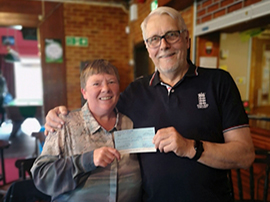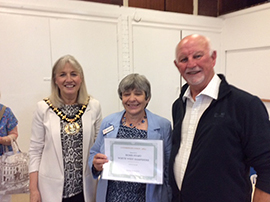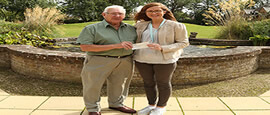![]() Calendar of meetings and events.
Calendar of meetings and events.
![]() Directions to us including Google maps
Directions to us including Google maps
![]() The United Grand Lodge of England
The United Grand Lodge of England
![]() Oxfordshire Provincial Grand Lodge
Oxfordshire Provincial Grand Lodge
![]() Masonic Charitable Foundation
Masonic Charitable Foundation
![]() Royal Masonic Benevolent Institution
Royal Masonic Benevolent Institution
![]() Calendar of meetings and events.
Calendar of meetings and events.
![]() Directions to us including Google maps
Directions to us including Google maps
![]() The United Grand Lodge of England
The United Grand Lodge of England
![]() Oxfordshire Provincial Grand Lodge
Oxfordshire Provincial Grand Lodge
![]() Masonic Charitable Foundation
Masonic Charitable Foundation
![]() Royal Masonic Benevolent Institution
Royal Masonic Benevolent Institution
 St. Peters Church Caversham Caversham's parish church of St Peter was founded around 1162. During the late 19th century the church was virtually rebuilt and a further chapel was erected in 1924 as a memorial to those who died in the Great War. Among the medieval features that survive are the Norman inner doorway of the porch, a couple of 12th century walls in the north east corner, and the baptismal font. Picture by Edward Lever / PicturesofEngland.com
St. Peters Church Caversham Caversham's parish church of St Peter was founded around 1162. During the late 19th century the church was virtually rebuilt and a further chapel was erected in 1924 as a memorial to those who died in the Great War. Among the medieval features that survive are the Norman inner doorway of the porch, a couple of 12th century walls in the north east corner, and the baptismal font. Picture by Edward Lever / PicturesofEngland.com 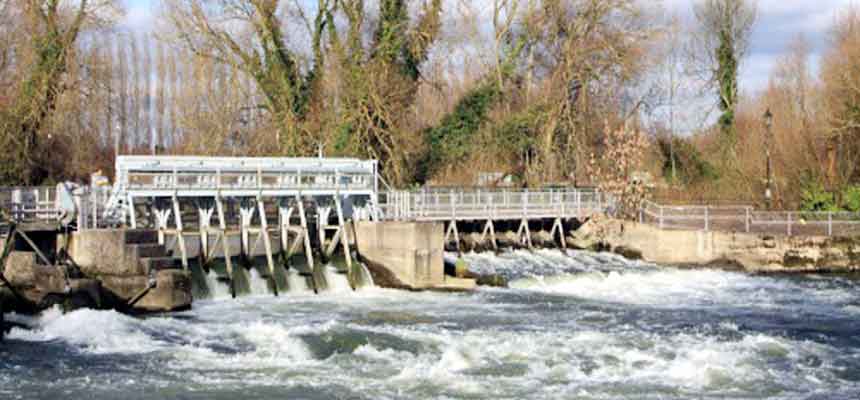 The Clappers Caversham weir on the Thames. Affectionally known as 'the clappers' maybe because of the noise? It also provides a foot crossing across the Thames from Lower Caversham into Reading via a bridge over the old mill stream, along View Island across the weir to deBohun Island, then over Caversham Lock to King's Meadow. The weir is now electronically automated to maintain river levels and to prevent flooding.
The Clappers Caversham weir on the Thames. Affectionally known as 'the clappers' maybe because of the noise? It also provides a foot crossing across the Thames from Lower Caversham into Reading via a bridge over the old mill stream, along View Island across the weir to deBohun Island, then over Caversham Lock to King's Meadow. The weir is now electronically automated to maintain river levels and to prevent flooding.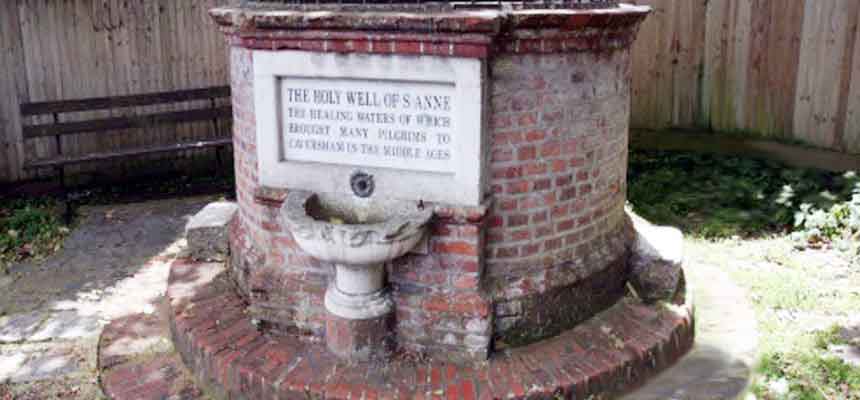 St Anne's Well The Holy Well of St Anne, bought many pilgrims to Caversham in the Middle Ages, the healing waters of which was supposed to cure many ills. A shrine existed beside the River at the time of the arrival of the Normans. Later, a chapel dedicated to St. Anne was situated on the Caversham side of the first bridge here across the Thames. By the 15th century the statue was plated in silver. Catherine of Aragon is recorded as visiting in 1532. The shrine was destroyed in 1538 under the orders of Henry VIII. Only the well survives. Picture by Edward Lever / PicturesofEngland.com
St Anne's Well The Holy Well of St Anne, bought many pilgrims to Caversham in the Middle Ages, the healing waters of which was supposed to cure many ills. A shrine existed beside the River at the time of the arrival of the Normans. Later, a chapel dedicated to St. Anne was situated on the Caversham side of the first bridge here across the Thames. By the 15th century the statue was plated in silver. Catherine of Aragon is recorded as visiting in 1532. The shrine was destroyed in 1538 under the orders of Henry VIII. Only the well survives. Picture by Edward Lever / PicturesofEngland.com 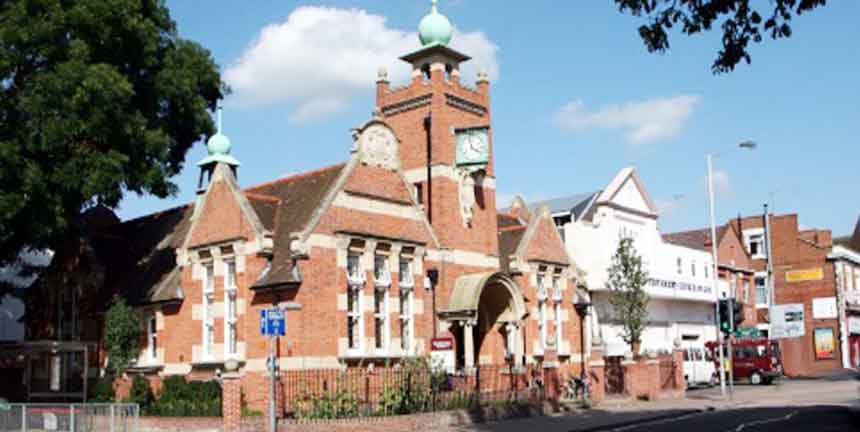 Caversham Library This classic building stands in the centre of Caversham and is regularly used by the residents and local schoolchildren. Caversham Library opened in 1907, and is a "Carnegie Library". It is one of several hundred in the U.K. financed by the Scottish American industrialist and philanthropist Andrew Carnegie. Next door you can see the New Testament Church of God, formally 'The Glendale' a privately owned cinema.
Caversham Library This classic building stands in the centre of Caversham and is regularly used by the residents and local schoolchildren. Caversham Library opened in 1907, and is a "Carnegie Library". It is one of several hundred in the U.K. financed by the Scottish American industrialist and philanthropist Andrew Carnegie. Next door you can see the New Testament Church of God, formally 'The Glendale' a privately owned cinema.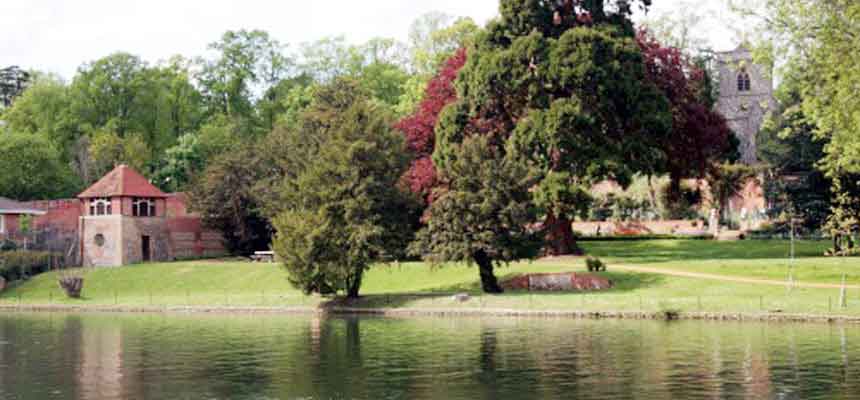 Caversham Court Close by St Peter’s Church stood Caversham Rectory after which Old Rectory Lodge was named, later to become Caversham Court, part of which was erected during the 17th century. Unfortunately the house was later demolished but the beautiful terraced gardens and dovecote remain a graceful riverside haven for visitors. The gardens and wooden entrance gates have recently been restored with the aid of a Heritage Lottery Grant. Picture by Edward Lever / PicturesofEngland.com
Caversham Court Close by St Peter’s Church stood Caversham Rectory after which Old Rectory Lodge was named, later to become Caversham Court, part of which was erected during the 17th century. Unfortunately the house was later demolished but the beautiful terraced gardens and dovecote remain a graceful riverside haven for visitors. The gardens and wooden entrance gates have recently been restored with the aid of a Heritage Lottery Grant. Picture by Edward Lever / PicturesofEngland.com  Caversham Park Old Caversham Park was built by William Knollys, 1st Earl of Banbury. There have been many grand houses since on this site, the present building being erected by the Crawshay family after a fire in 1850. The house was for a time home to The Oratory School which moved in 1942 when Caversham Park was requisitioned to become a World War II BBC listening station. It is now the BBC World monitoring station and also home to BBC Radio Berkshire.
Caversham Park Old Caversham Park was built by William Knollys, 1st Earl of Banbury. There have been many grand houses since on this site, the present building being erected by the Crawshay family after a fire in 1850. The house was for a time home to The Oratory School which moved in 1942 when Caversham Park was requisitioned to become a World War II BBC listening station. It is now the BBC World monitoring station and also home to BBC Radio Berkshire. 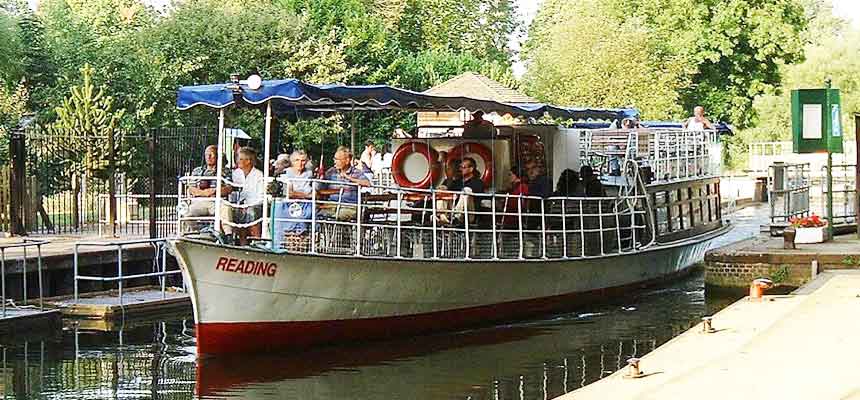 Caversham Lock Caversham Lock showing one of Salter's Steamers, Reading. The original lock was built by the Thames Navigation Commissioners in 1778 and was rebuilt in 1875. The current Lock has won many prizes for its glorious display of flowers in the summer. Before the gates were motorised many local children jumped at the chance to help the Lock Keeper open the gates.
Caversham Lock Caversham Lock showing one of Salter's Steamers, Reading. The original lock was built by the Thames Navigation Commissioners in 1778 and was rebuilt in 1875. The current Lock has won many prizes for its glorious display of flowers in the summer. Before the gates were motorised many local children jumped at the chance to help the Lock Keeper open the gates. 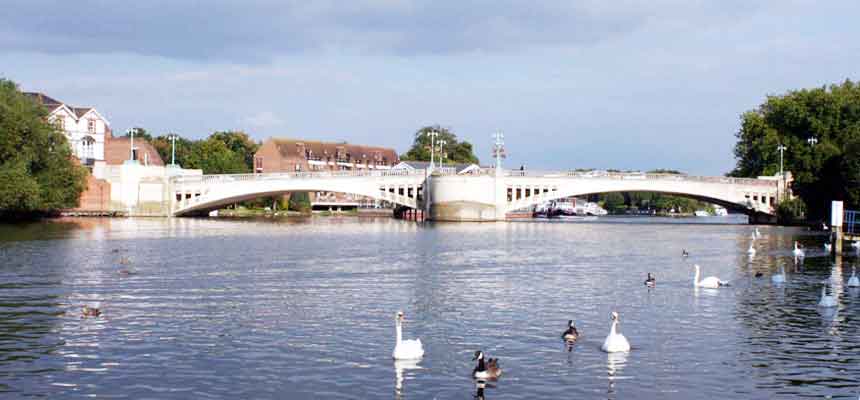 Caversham Bridge Caversham Bridge taken from the Reading bank of the River Thames. There has been a bridge at Caversham since the 12th Century. During the Civil War, the bridge was fiercely fought over by the Royalists and the Parliamentary armies for control of Reading. The current bridge was built in 1926 following the completion of Reading Bridge in 1923 and was opened by Edward, the then Prince of Wales.
Caversham Bridge Caversham Bridge taken from the Reading bank of the River Thames. There has been a bridge at Caversham since the 12th Century. During the Civil War, the bridge was fiercely fought over by the Royalists and the Parliamentary armies for control of Reading. The current bridge was built in 1926 following the completion of Reading Bridge in 1923 and was opened by Edward, the then Prince of Wales. 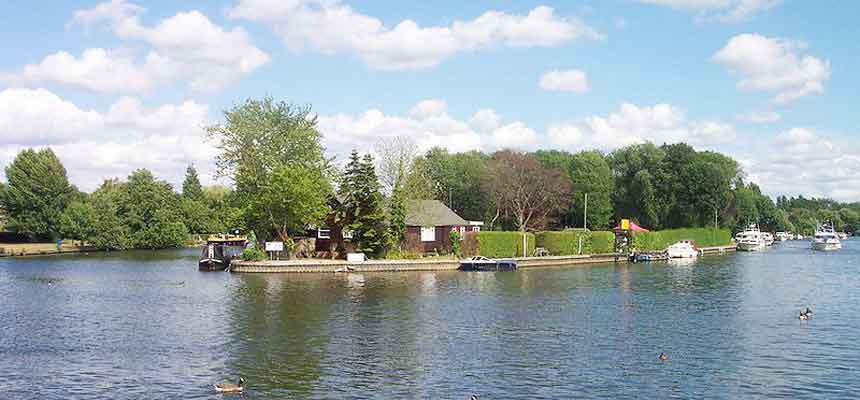 de Montfort Island de Montfort or Fry's Island showing the Island Bohemian Club end from the Reading bank. The club has been in existence for over 100 years and was formally known as the Old Codgers Club! It was on this island in 1163 that Robert de Montfort fought the earl of Essex in a 'Trial by Combat' in front of King Henry II. Essex, the King's Standard Bearer had been accused of cowardice and treason for leaving the field of battle. Obviously de Montfort won, hence the island's name.
de Montfort Island de Montfort or Fry's Island showing the Island Bohemian Club end from the Reading bank. The club has been in existence for over 100 years and was formally known as the Old Codgers Club! It was on this island in 1163 that Robert de Montfort fought the earl of Essex in a 'Trial by Combat' in front of King Henry II. Essex, the King's Standard Bearer had been accused of cowardice and treason for leaving the field of battle. Obviously de Montfort won, hence the island's name. © 2020 • Caversham Masonic Building Association. All rights reserved

